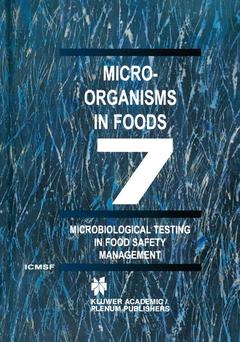1—Microbiological Hazards and Their Control.- 1.1 Introduction.- 1.2 History.- 1.3 The Concept of a Food Safety Management System.- 1.4 Historical Development.- 1.5 Status of Foodborne Illness: Etiologic Agents or Contaminants.- 1.6 Practices Contributing to Foodborne Illness.- 1.7 Importance of Effective Control Measures.- 1.8 Effectiveness of GHP and HACCP.- 1.9 Would an FSO Improve Food Safety and Reduce Foodborne Illness?.- 1.10 Use of FSOs in Food Safety Management.- 1.11 Performance, Process, Product, and Default Criteria.- 1.12 Establishment of Control Measures.- 1.13 Assessment of Control of a Process.- 1.14 Acceptance Criteria.- 1.15 Microbiological Criteria.- 1.16 Microbiological Tests.- 1.17 Summary.- 1.18 References.- 2—Evaluating Risks and Establishing Food Safety Objectives.- 2.1 Introduction.- 2.2 Tolerable Level of Consumer Protection.- 2.3 Importance of Epidemiologic Data.- 2.4 Evaluation of Risk.- 2.5 Food Safety Objectives (FSOs).- 2.6 Establishment of an FSO Based on a Risk Evaluation by an Expert Panel.- 2.7 Evaluation of Risk by Quantitative Risk Assessment.- 2.8 Establishment of an FSO Based on Quantitative Risk Assessment.- 2.9 Stringency of FSOs in Relation to Risk and Other Factors.- 2.10 Summary.- 2.11 References.- 3—Meeting The Fso Through Control Measures.- 3.1 Introduction.- 3.2 Control Measures.- 3.3 Confirm That the FSO Is Technically Achievable.- 3.4 Importance of Control Measures.- 3.5 Performance Criteria.- 3.6 Process and Product Criteria.- 3.7 The Use of Microbiological Sampling and Performance Criteria.- 3.8 Default Criteria.- 3.9 Process Validation.- 3.10 Monitoring and Verifying Control Measures.- 3.11 Examples of Control Options.- 3.12 Assessing Equivalency of Food Safety Management Systems.- 3.13 References.- Appendix 3-A: Control Measures Commonly Applied to Foodborne Diseases.- 4—Selection and Use of Acceptance Criteria.- 4.1 Introduction.- 4.2 Equivalence.- 4.3 Establishment of Acceptance Criteria.- 4.4 Application of Acceptance Criteria.- 4.5 Determining Acceptance by Approval of Supplier.- 4.6 Examples To Demonstrate the Process of Lot Acceptance.- 4.7 Auditing Food Operations for Supplier Acceptance.- 4.8 References.- 5—Establishment of Microbiological Criteria for Lot Acceptance.- 5.1 Introduction.- 5.2 Purposes and Application of Microbiological Criteria for Foods.- 5.3 Definition of Microbiological Criterion.- 5.4 Types of Microbiological Criteria.- 5.5 Application of Microbiological Criteria.- 5.6 Principles for the Establishment of Microbiological Criteria.- 5.7 Components of Microbiological Criteria for Foods.- 5.8 Examples of Microbiological Criteria Ill.- 5.9 References.- 6—Concepts of Probability and Principles of Sampling.- 6.1 Introduction.- 6.2 Probability.- 6.3 Population and Sample of the Population.- 6.4 Choosing the Sample Units.- 6.5 The Sampling Plan.- 6.6 The Operating Characteristic Function.- 6.7 Consumer Risk and Producer Risk.- 6.8 Stringency and Discrimination.- 6.9 Acceptance and Rejection.- 6.10 What Is a Lot?.- 6.11 What Is a Representative Sample?.- 6.12 Confidence in Interpretation of Results.- 6.13 Practical Considerations.- 6.14 References.- 7—Sampling Plans.- 7.1 Introduction.- 7.2 Attributes Plans.- 7.3 Variables Plans.- 7.4 Comparison of Sampling Plans.- 7.5 References.- 8—Selection of Cases and Attributes Plans.- 8.1 Introduction.- 8.2 Microbial Criteria: Utility, Indicator, and Pathogens.- 8.3 Factors Affecting the Risk Associated with Pathogens.- 8.4 Categorizing Microbial Hazards According to Risk.- 8.5 Definition of Cases.- 8.6 Deciding between Two-Class and Three-Class Attributes Sampling Plans.- 8.7 Determining Values for m and M.- 8.8 Specific Knowledge about the Lot.- 8.9 What Is a Satisfactory Probability of Acceptance?.- 8.10 Selecting n and c.- 8.11 Sampling Plan Performance of the Cases.- 8.12 References.- Appendix 8-A: Ranking of Foodborne Pathogens or Toxins into Hazard Groups.- 9—Tightened, Reduced, and Investigational Sampling.- 9.1 Introduction.- 9.2 Application of Tightened Sampling and Investigational Sampling.- 9.3 Tightened Sampling Plans.- 9.4 Example of the Influence of Sampling Plan Stringency in Detecting Defective Lots.- 9.5 Selecting the Sampling Plan According to Purpose.- 9.6 Reduced Sampling.- 9.7 References.- 10—Experience in The Use Of Two-Class Attributes Plans for Lot Acceptance.- 10.1 Introduction.- 10.2 The Concept of Zero Tolerance.- 10.3 The Need for Compromise.- 10.4 Application of Two-Class Sampling Plans for Pathogens Such as Salmonella.- 10.5 Problems in the Implementation of Stringent Sampling Plans.- 10.6 Relation to Commercial Practice.- 10.7 Discrepancies between Original and Retest Results.- 10.8 Summary.- 10.9 References.- 11—Sampling to Assess Control of The Environment.- 11.1 Introduction.- 11.2 Principles of GHP.- 11.3 Post-Process Contamination.- 11.4 Establishment and Growth of Pathogens in the Food Processing Environment.- 11.5 Measures To Control Pathogens in the Food Processing Environment.- 11.6 Sampling the Processing Environment.- 11.7 References.- 12—Sampling, Sample Handling, and Sample Analysis.- 12.1 Introduction.- 12.2 Collection of Sample Units.- 12.3 Intermediate Storage and Transportation.- 12.4 Reception of Samples.- 12.5 Sample Analysis.- 12.6 Recovery of Injured Cells.- 12.7 Errors Associated with Methods and Performance of Laboratories.- 12.8 References.- 13—Process Control.- 13.1 Introduction.- 13.2 Knowledge of the Degree of Variability and the Factors That Influence Variability.- 13.3 Process Capability Study.- 13.4 Control during Production: Monitoring and Verifying a Single Lot of Food.- 13.5 Control during Production: Organizing Data from Across Multiple Lots of Food To Maintain or Improve Control.- 13.6 Use of Process Control Testing as a Regulatory Tool.- 13.7 Investigating and Learning from Previously Unrecognized Factors or Unforeseen Events.- 13.8 References.- 14—Aflatoxins in Peanuts.- 14.1 Introduction.- 14.2 Risk Assessment.- 14.3 Risk Management.- 14.4 Acceptance Criteria for Final Product.- 14.5 References.- 15—Salmonella in Dried Milk.- 15.1 Introduction.- 15.2 Risk Evaluation.- 15.3 Risk Management.- 15.4 Product and Process Criteria.- 15.5 GHP and HACCP.- 15.6 Acceptance Criteria for Final Product.- 15.7 References.- 16—Listeria Monocytogenes in Cooked Sausage (Frankfurters).- 16.1 Introduction.- 16.2 Risk Evaluation.- 16.3 Risk Management.- 16.4 Process and Product Criteria.- 16.5 GHP and HACCP.- 16.6 Acceptance Criteria for Final Product.- 16.7 References.- 17 —E Coli O157:H7 In Frozen Raw Ground Beef Patties.- 17.1 Introduction.- 17.2 Risk Evaluation.- 17.3 Risk Management.- 17.4 Control Measures.- 17.5 Acceptance Criteria.- 17.6 Statistical Implications of the Proposed Sampling Plan.- 17.7 References.- Appendix A—Glossary.- Appendix B—Objectives and Accomplishments of the International Commission on Microbiological Specifications for Foods.- Appendix C—ICMSF Participants.- Appendix D—Publications of the ICMSF.- Appendix E—Table of Sources.

